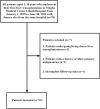Impact of human leukocyte antigen mismatch between donor-recipient on acute rejection in liver transplantation using next-generation sequencing: a single-center study
- PMID: 40463387
- PMCID: PMC12129760
- DOI: 10.3389/fimmu.2025.1576815
Impact of human leukocyte antigen mismatch between donor-recipient on acute rejection in liver transplantation using next-generation sequencing: a single-center study
Abstract
Background: The effect of human leukocyte antigen (HLA) mismatch on acute rejection (AR) in liver transplantation (LT) is controversial. This study aimed to investigate the effect of donor-recipient mismatch at the HLA-A, -B, -C, -DRB1, -DRB3, -DRB4, -DRB5, -DQA1, -DQB1, -DPA1, and -DPB1 loci on AR in LT.
Methods: In total, 92 patients who underwent LT were selected for investigation from 1 January 2018 to 30 June 2024, and the donors of these patients were also from the same hospital. All donor and recipient specimens were genotyped via next-generation sequencing (NGS) for the 11 HLA loci. The patients were divided into AR and non-AR groups according to whether AR occurred after LT.
Results: A total of 12 cases (13.04%) experienced AR after LT. The proportion of chronic hepatitis B virus (HBV) infection was lower in the AR group than that in the non-AR group (P<0.05), while the proportion of split LT and mortality within 1 year after transplantation was higher in the AR group than in the non-AR group (P<0.05). Compared with the non-AR group, the AR group had a significantly higher proportion of high-mismatch DQB1 (2 vs. 0-1) and DRB1+DQB1 (4 vs. 0-3) (P<0.05) at the allele level, and other mismatches of a single locus and different combinations of the 11 HLA loci had no significant differences between the two groups (P>0.05). However, neither high-mismatch DQB1 nor high-mismatch DRB1+DQB1 at the allele level was an independent risk factor for AR after adjustment for chronic HBV infection, LT operative procedures, and immunosuppressive regimen using bootstrapping [odds ratio (OR): 0.203, 95% confidence interval (CI): 0.000-1.300, P=0.067; OR: 0.404, 95% CI: 0.000-2.625, P=0.172, respectively].
Conclusion: In this preliminary study, no correlation between HLA mismatch at the allele level and post-transplant AR episodes was found.
Keywords: acute rejection; human leukocyte antigen; liver transplantation; mismatch; next-generation sequencing.
Copyright © 2025 Lu, Lu, He, Chen and Zhu.
Conflict of interest statement
The authors declare that the research was conducted in the absence of any commercial or financial relationships that could be construed as a potential conflict of interest.
Figures



Similar articles
-
HLA variants related to primary sclerosing cholangitis influence rejection after liver transplantation.World J Gastroenterol. 2014 Apr 14;20(14):3986-4000. doi: 10.3748/wjg.v20.i14.3986. World J Gastroenterol. 2014. PMID: 24744588 Free PMC article.
-
Allele and haplotype frequencies of human leukocyte antigen-A, -B, -C, -DRB1, -DRB3/4/5, -DQA1, -DQB1, -DPA1, and -DPB1 by next generation sequencing-based typing in Koreans in South Korea.PLoS One. 2021 Jun 21;16(6):e0253619. doi: 10.1371/journal.pone.0253619. eCollection 2021. PLoS One. 2021. PMID: 34153078 Free PMC article.
-
[The impact of HLA high resolution typing mismatching of donor-recipient pairs on outcome of unrelated donor hematopoietic stem cell transplantation].Zhonghua Xue Ye Xue Za Zhi. 2012 May;33(5):353-7. Zhonghua Xue Ye Xue Za Zhi. 2012. PMID: 22781790 Chinese.
-
HLA-DPB1 and DPA1 ~ DPB1 linkage mismatch affects the survival of recipients receiving HLA-14/14 matched unrelated donor HSCT.HLA. 2024 Jun;103(6):e15542. doi: 10.1111/tan.15542. HLA. 2024. PMID: 38887889
-
Association Between HLA-DRB1 Serotype and HLA-DQB1 Allele Mismatches and Acute Rejection in Kidney Transplantation.HLA. 2025 May;105(5):e70228. doi: 10.1111/tan.70228. HLA. 2025. PMID: 40400399 Free PMC article.
References
-
- Wong YJ, Singh N, Sanchez-Fernandez N, Montano-Loza AJ. Enhanced recovery for liver transplantation: recommendations from the 2022 International Liver Transplantation Society Consensus Conference: towards better clinical care in transplant hepatology. Hepatobiliary Surg Nutr. (2024) 13:512–5. doi: 10.21037/hbsn-24-7 - DOI - PMC - PubMed
-
- van Leeuwen OB, de Vries Y, Fujiyoshi M, Nijsten MWN, Ubbink R, Pelgrim GJ, et al. . Transplantation of high-risk donor livers after ex situ resuscitation and assessment using combined hypo- and normothermic machine perfusion: A prospective clinical trial. Ann surg. (2019) 270:906–14. doi: 10.1097/SLA.0000000000003540 - DOI - PubMed
MeSH terms
Substances
LinkOut - more resources
Full Text Sources
Medical
Research Materials

